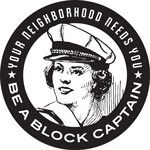image source: City of Albany, CA
Firewise groups can form with just 8 households. For groups over 25 households, leaders may want help communicating with neighbors and gathering information. Some larger groups in Berkeley are using a system of block captains.
To set up block captains, organizers carve up the group’s boundary area into sections. Each section has a captain. Some groups have 25 homes in a section, others have 10-12 homes in a section. If there isn’t a captain for every section, that is okay. Expect that a captain’s duties will take 9-12 hours a year. Captains are asked to check in with neighbors every 2 months or so. The leader sends information to captains asking them to help with specific tasks. Captains live within the section they are reaching out to and already know some of their neighbors when they knock on doors. Captains are the point of first contact for many neighbors, and being in repeated contact, they spread the word about the work Firewise is doing. Here is a list of possible tasks for a block captain
- explain the neighborhood’s effort to collectively make Firewise improvements and the value of contiguous homes prepared for wildfire. If there is not interest initially, that is okay. Move on to the next neighbor.
- collect contact information.
- recruit new members and encourage them to make improvements.
- answer questions, or send them to appropriate resources.
- offer to arrange for an inspection.
- hear concerns and bring issues back to the Firewise committee
- inform them about big events: a yearly organizing meeting, a vegetation removal day, or an important event, (e.g. supporting EMBER at a public meeting).
- ask if they need help completing Firewise tasks. There are grants available to help cover the cost of tree work. Some groups create “neighbors helping neighbors” work parties to remove vegetation.
- find out if someone in their home will need help evacuating, (or pre-evacuating) in an emergency.
- encourage people to log their time, expenses and vegetation removed.
Leaders provide each captain with a spreadsheet of information for the addresses in their section. Captains work to fill in blanks in the spreadsheet improving communication and understanding what people may need. The spreadsheet information includes:
- names and addresses of residents
- email and phone information
- If residents need help evacuating in an emergency
- If residents need help getting work done
Captains pass this information back to the leader who updates the spreadsheet for the whole group. Captains only see information for their section.
If a person doesn’t get along with their captain, captains can switch assigned residents.
This system of close contact with neighbors helps spread the word about Firewise and is the primary way that some larger groups recruit members and encourage involvement. It also spreads the workload among more people encouraging engagement and participation in the leadership structure of the group.
